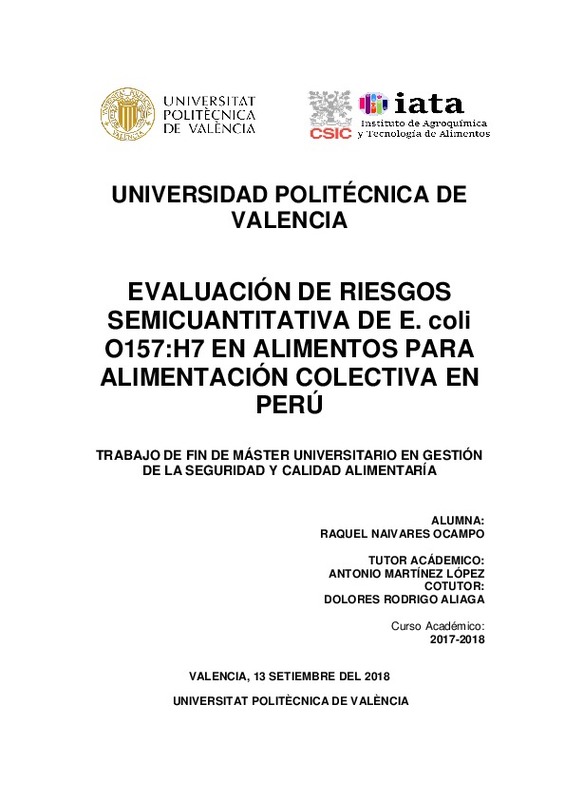|
Resumen:
|
[ES] En el presente trabajo se ha llevado a cabo una evaluación de riesgos semicuantitativa de Escherichia coli O157: H7 en hamburguesa y lechuga lista para su consumo con objeto de evaluar las herramientas Risk Ranger y ...[+]
[ES] En el presente trabajo se ha llevado a cabo una evaluación de riesgos semicuantitativa de Escherichia coli O157: H7 en hamburguesa y lechuga lista para su consumo con objeto de evaluar las herramientas Risk Ranger y sQMRA para su aplicación en comedores colectivos en Perú. Los resultados obtenidos indican que la lechuga lista para su consumo presenta un mayor riesgo para el consumidor que la hamburguesa. El riesgo relativo en el Risk Ranger es 62% en la hamburguesa y 69% en la lechuga lista para consumo. En el caso de sQMRA el resultado indica que el porcentaje del total de la población que enfermaría se estima en un 0,9% por consumo de hamburguesa y un 19% en el caso de la lechuga lista para su consumo. Esta herramienta también nos dice que, en el caso de la hamburguesa, el factor que más contribuye en la exposición y el número de casos es la contaminación cruzada, mientras que en la lechuga es el hecho que se consume cruda.
En relación al resultado comparativo entre ambas herramientas, se puede decir que no hay diferencias importantes en cuanto a la apreciación del riesgo (riesgo relativo) ni en cuanto al número estimado de enfermos resultante del consumo de ambos alimentos, considerando los parámetros de entrada para ambos modelos, que provienen del estudio y análisis de las bases de datos disponibles.
En consecuencia, este estudio nos permite concluir que ambas herramientas son simples y que podrían ser muy útiles para priorizar los riesgos en los comedores colectivos en el Perú. Sin embargo, consideramos que la herramienta sQMRA proporciona más información.
[-]
[EN] In the present work, a semiquantitative risk assessment of Escherichia coli O157: H7 in hamburger and lettuce ready for consumption was carried out to evaluate the Risk Ranger and sQMRA tools for its application in ...[+]
[EN] In the present work, a semiquantitative risk assessment of Escherichia coli O157: H7 in hamburger and lettuce ready for consumption was carried out to evaluate the Risk Ranger and sQMRA tools for its application in collective dining rooms in Peru. The results obtained indicate that lettuce ready for consumption presents a greater risk to the consumer than hamburger. The relative risk in the Risk Ranger is 62% in the hamburger and 69% in the lettuce ready for consumption. In the case sQMRA the result indicates that the percentage of the total population that would be sick is estimated at 0.9% for hamburger consumption and 19% in the case of lettuce ready for consumption. This tool also tells us that, in the case of the hamburger, the factor that most contributes to the exposure and the number of cases is cross contamination, while in lettuce it is the fact that it is consumed raw.
In relation to the comparative result between both tools, it can be said that there are no important differences in terms of risk assessment (relative risk) or in the estimated number of patients resulting from the consumption of both foods, considering the input parameters for both models, which come from the study and analysis of the available databases.
Consequently, this study allows us to conclude that both tools are simple and that they could be very useful to prioritize risks in collective dining rooms in Peru. However, we consider that the sQMRA tool provides more information.
[-]
|







